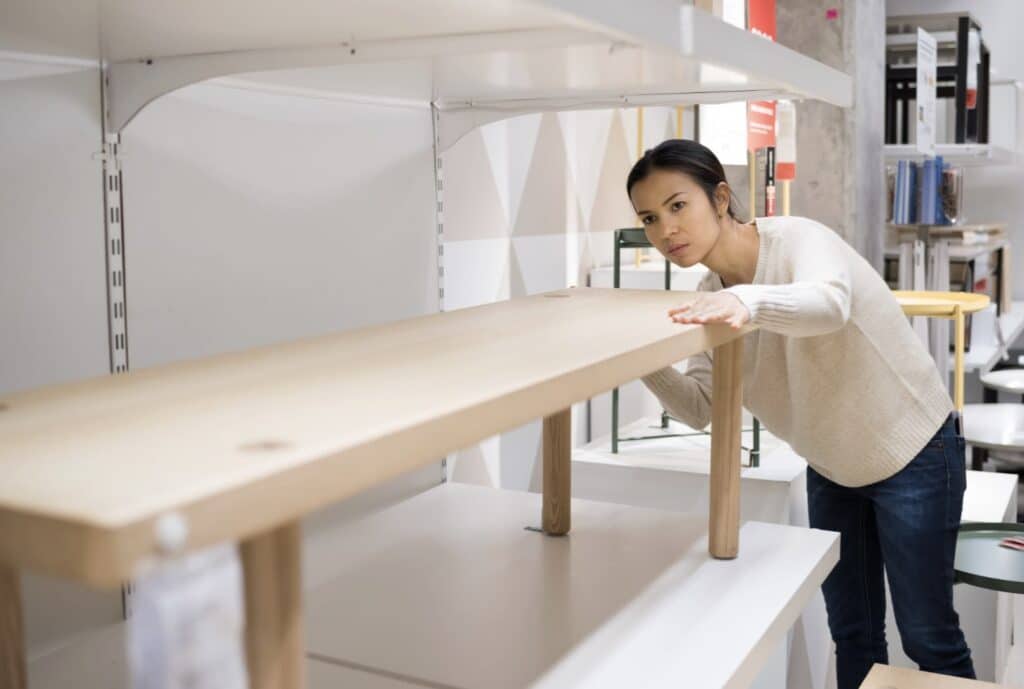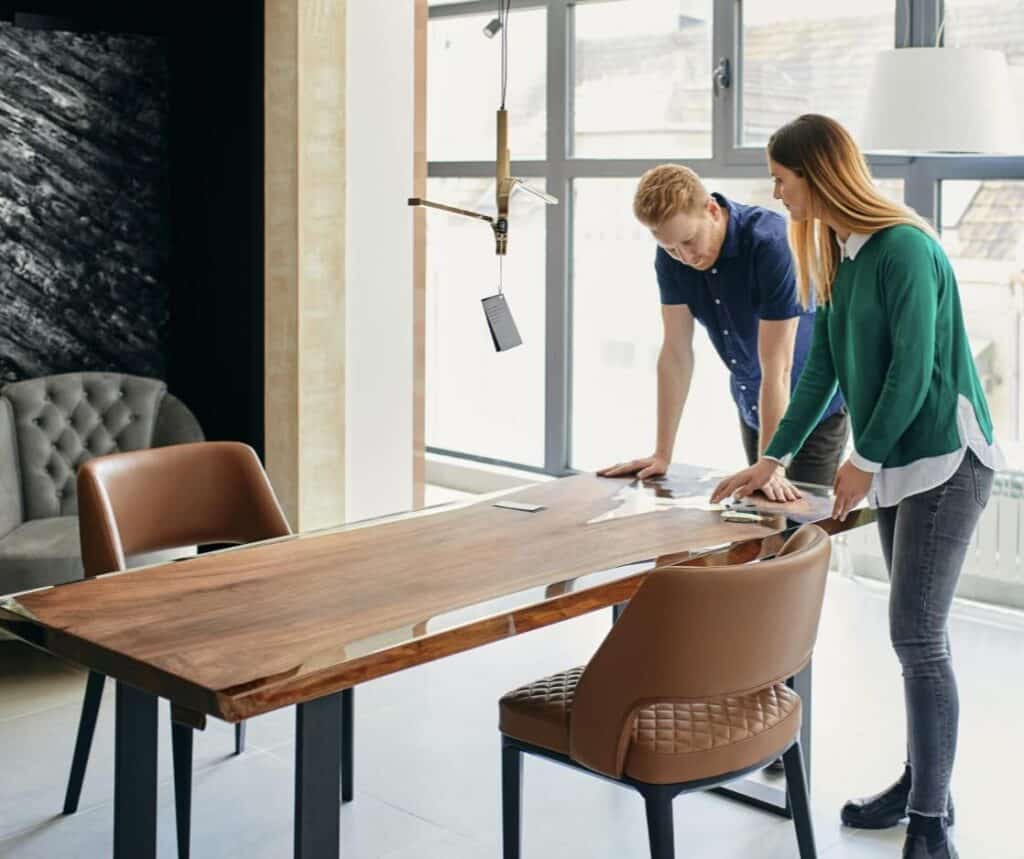Buying furniture is an exciting yet often overwhelming experience. With countless options available, it can be challenging to determine which pieces are truly worth your investment.
High-quality furniture is not just about looks—it’s about durability, functionality, and craftsmanship that stands the test of time. Whether you’re furnishing a new home or upgrading your current space, knowing how to evaluate furniture craftsmanship is essential for making informed decisions. Read on as we provide a comprehensive buyer’s checklist to help you assess the quality of furniture, from the materials used to the design details that ensure longevity and style.
Table of Contents
- Why Furniture Craftsmanship Matters
- Tips for Buying Quality Furniture
- Caring for High-Quality Furniture
- Related Content
Why Furniture Craftsmanship Matters
Craftsmanship is the backbone of any quality furniture piece. Well-made furniture offers several benefits:
- Durability: High-quality furniture lasts for years, saving you money in the long run.
- Aesthetic Appeal: Superior craftsmanship enhances the beauty and uniqueness of a piece.
- Functionality: Thoughtful design ensures that furniture serves its purpose effectively.
- Sustainability: High-quality furniture is often crafted with eco-friendly materials and production processes.
Investing in well-crafted furniture is not just a financial decision—it’s about creating a home environment that reflects your values and style.

The Buyer’s Checklist for Evaluating Furniture Craftsmanship
1. Inspect the Materials
The materials used in furniture play a critical role in its quality and durability. Solid wood, metal, and high-quality upholstery are hallmarks of well-crafted pieces.
- Solid Wood: Look for furniture made from hardwoods like oak, walnut, or mahogany. These woods are durable and resistant to wear and tear.
- Engineered Wood: Plywood and MDF (medium-density fiberboard) can be good options for budget-friendly furniture, but should be paired with quality veneers.
- Metal: Stainless steel, wrought iron, and brass are strong and long-lasting materials for frames and accents.
- Upholstery: Opt for durable fabrics like leather, cotton, or high-grade synthetics. Poor-quality upholstery will wear out quickly.
2. Examine the Construction
The construction of furniture determines how well it will withstand the test of time. Pay attention to the joints, fasteners, and overall assembly.
- Joints: High-quality furniture employs sturdy joint techniques, such as dovetail, mortise-and-tenon, or tongue-and-groove. Avoid pieces held together with staples or glue alone.
- Fasteners: Opt for screws and bolts over nails or weak adhesives. Screws provide better stability and durability.
- Frame: For upholstered furniture, the frame should be made of solid wood or metal—not particleboard or plastic.
- Reinforcements: Check for corner blocks or brackets that add strength to the construction.
3. Assess the Finish
The finish of furniture affects its appearance and protects the material from damage. A high-quality finish is smooth, even, and durable.
- Wood Finish: Look for a consistent stain or paint application without streaks or blotches. The finish should enhance the natural grain of the wood.
- Metal Finish: Metal surfaces should be polished or coated to prevent rust and corrosion.
- Upholstery Finish: Check for tight seams and consistent stitching. Loose or uneven stitching is a sign of poor craftsmanship.
4. Check the Functionality
Furniture should not only look good but also serve its intended purpose effectively. Test the functionality of the piece before making a purchase.
- Drawers: Open and close drawers to ensure they glide smoothly and don’t stick. High-quality drawers often have dovetail joints and metal runners.
- Doors: Cabinet doors should open and close easily, with sturdy hinges and proper alignment.
- Chairs and Sofas: Sit on chairs and sofas to check for comfort and stability. The frame should feel solid, and the cushions should retain their shape.
- Tables: Tables should be level and stable, with no wobbling or uneven legs.
5. Evaluate the Design
Good design combines aesthetics with practicality. It should complement your home while meeting your functional needs.
- Proportions: The furniture should have balanced proportions that are visually pleasing.
- Details: Handcrafted details, such as carvings, inlays, or stitching, add uniqueness and character.
- Versatility: Consider whether the piece can adapt to different spaces or uses over time.
- Timelessness: Opt for designs that won’t quickly go out of style, ensuring long-term value.
6. Test for Durability
Durability is a key indicator of quality craftsmanship. Furniture should be able to withstand daily use without showing signs of wear.
- Weight: Solid wood and metal furniture are typically heavier and more durable than lightweight alternatives.
- Scratch Resistance: Test the surface for resistance to scratches or dents. High-quality finishes protect against damage.
- Stability: Shake or move the furniture to check for wobbling or instability.
7. Look for Labels and Certifications
Many manufacturers include labels or certifications that indicate the quality and origin of their furniture.
- Brand Reputation: Research the manufacturer to ensure they have a proven track record of producing high-quality pieces. In our experience, high-quality brands consistently ensure their furniture meets the required quality standards.
- Certifications: Look for certifications like FSC (Forest Stewardship Council) for sustainable wood or GREENGUARD for low chemical emissions.
- Country of Origin: Furniture made in countries with strong craftsmanship traditions, such as Italy or Denmark, often reflects higher quality. Although Europe is renowned for its quality, in recent years, countries such as China and Vietnam have also been producing high-quality furniture.
8. Ask About Warranty and Return Policies
A good warranty or return policy is a sign that the manufacturer stands behind their craftsmanship.
- Warranty: Check if the furniture comes with a warranty that covers defects in materials or construction.
- Return Policy: Ensure you can return the piece if it doesn’t meet your expectations.

Common Signs of Poor Craftsmanship
While evaluating furniture, watch out for these red flags that indicate low quality:
- Visible Staples or Glue: This suggests weak construction and a lack of attention to detail.
- Uneven Finish: Blotchy stains or rough paint indicate poor finishing techniques.
- Wobbly Frames: Unstable frames are a sign of weak materials or assembly.
- Loose Seams: Upholstery with loose or uneven stitching will wear out quickly.
- Warped Surfaces: Warping or bending indicates the use of low-quality wood or improper storage.
Tips for Buying Quality Furniture
1. Shop at Reputable Stores
Purchase furniture from trusted retailers or manufacturers known for their quality and craftsmanship—research reviews and customer feedback before making a decision.
2. Invest in Timeless Pieces
Choose furniture with classic designs that won’t go out of style. Timeless pieces are more likely to retain their value and complement a wide range of decor styles.
3. Test Before You Buy
Whenever possible, test the furniture in person. Sit in the chairs, open the drawers, and inspect the finishes to ensure the piece meets your expectations.
4. Don’t Sacrifice Quality for Price
While a budget is essential, avoid buying furniture solely based on price. Cheap furniture often lacks durability and craftsmanship, costing you more in the long run.
5. Consider Custom Options
Custom furniture allows you to choose materials, finishes, and designs that suit your preferences. While more expensive, custom pieces often offer superior craftsmanship.

Caring for High-Quality Furniture
Once you’ve invested in well-crafted furniture, proper care will ensure it lasts for years to come. Follow these tips to maintain its beauty and functionality:
Wood Furniture Care
- Dust regularly with a soft cloth to prevent buildup.
- Avoid placing wood furniture in direct sunlight to prevent fading.
- Use coasters and placemats to protect surfaces from scratches and stains.
Metal Furniture Care
- Clean metal surfaces with a damp cloth and mild soap.
- Apply a protective coating to prevent rust and corrosion.
- Avoid dragging metal furniture to prevent scratches on floors.
Upholstered Furniture Care
- Vacuum upholstered furniture to remove dust and debris.
- Spot clean stains immediately with a gentle cleaning solution.
- Rotate cushions regularly to maintain their shape.
Evaluating furniture craftsmanship is an essential skill for any buyer. By inspecting materials, construction, finish, functionality, design, and durability, you can confidently select pieces that are built to last. Remember to look for labels, certifications, and warranties that reflect the manufacturer’s commitment to quality.

At Mondoro.com, we believe furniture should be more than just functional—it should be a reflection of your style and values.
By following this buyer’s checklist, you’ll be equipped to invest in high-quality furniture that enhances your home and provides lasting satisfaction. Whether you’re furnishing a single room or an entire house, choosing well-crafted furniture is a decision that pays off for years to come.
Find out more about how Mondoro can help you create, develop, and manufacture excellent home decor and furniture products – don’t hesitate to contact me, Anita. Check out my email by clicking here or become a part of our community and join our newsletter by clicking here.
Mondoro gives out a FREE Lookbook to anyone interested. You can receive a copy of our latest Lookbook by clicking here.
Listen to our Podcast called Global Trade Gal. You can find it on all major podcast platforms. Try out listening to one of our podcasts by clicking here.
Subscribe to our Mondoro Company Limited YouTube Channel with great videos and information by clicking here.
Related Content
What is Spun Bamboo? Using Spun Bamboo in Product Development
Spun bamboo was invented in Vietnam over 800 years ago to give a cheaper alternative to the home decor and home utensil materials that were then being used. Spun bamboo is called spun bamboo as it is spun out pieces of bamboo, and then the bamboo pieces are glued together into a form. This spun bamboo production helps women in these villages earn an extra income. Spun bamboo is a great natural product and can be used in a variety of home decor and kitchen products.
You can learn more by reading our blog, What is Spun Bamboo? Using Spun Bamboo in Product Development by clicking here.
Bamboo’s Strength: Reviewing The Flexibility And Durability Of Bamboo
Apart from its strength, bamboo is also renowned for its flexibility. It can bend without breaking, providing an added advantage in areas prone to earthquakes or other natural disasters. In these instances, the flexibility of bamboo enables it to withstand intense pressure and absorb shocks far better than rigid materials like concrete or steel.
You can read our blog about Bamboo’s Strength: Reviewing The Flexibility And Durability Of Bamboo by clicking here.
How Strong Is Bamboo?
Bamboo is one of the strongest and most versatile materials in the world. It has been used in construction, furniture-making, and even as a source of food and medicine for centuries. Bamboo is known for its fast-growing nature, as well as its incredible strength and durability. In this blog post, we will explore the strength of bamboo and compare it to other woods, such as oak, maple, and teak.
You can learn more by reading our blog, How Strong Is Bamboo? by clicking here.

